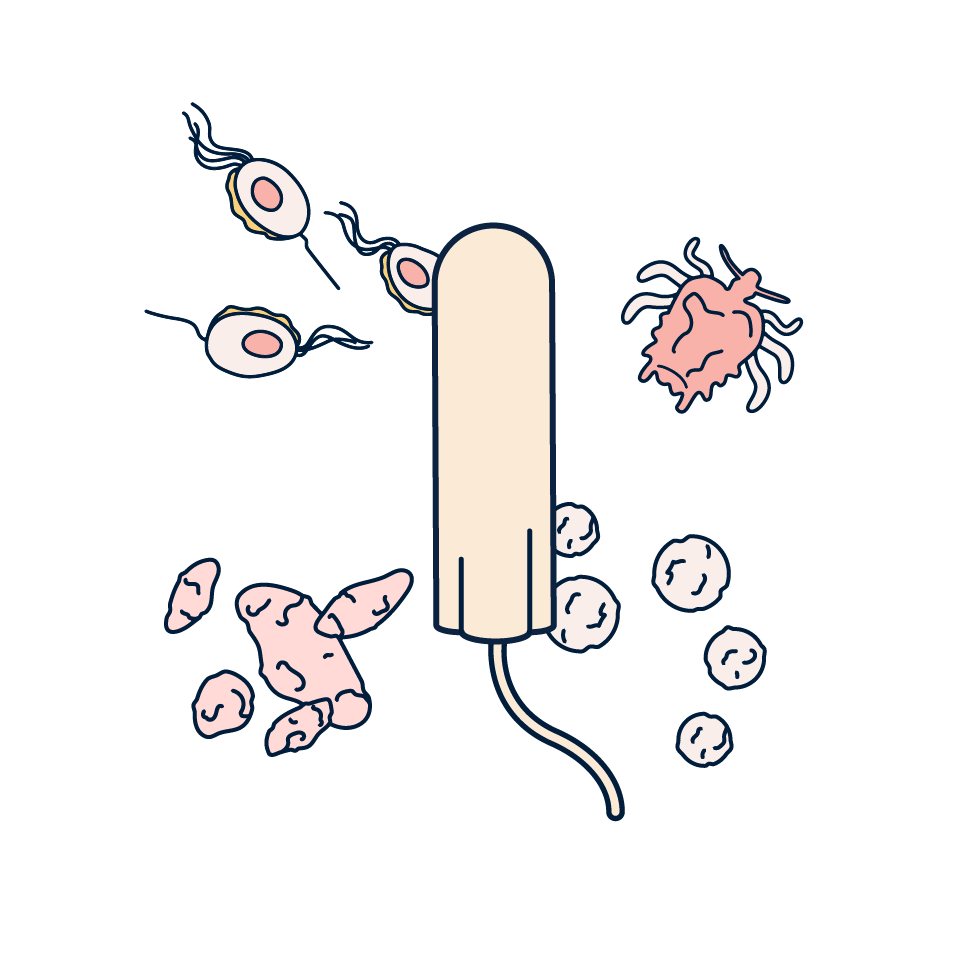Table of contents
1. Myth 1: At-Home STI Tests Are Less Accurate
2. Myth 2: Positive Results from Home Tests Are Often False
3. Myth 3: At-Home Tests Are Unhelpful Because They Don't Test For Every STI
4. Myth 4: At-Home STI Testing is Unnecessary if You're Asymptomatic
5. Myth 5: At-Home Tests are More Complicated
6. Conclusion
Written by Izzie Price
Medically reviewed by Sarah Montagu (RN DFSRH, BSc)
Illustrated by Maria Papazova
Let’s face it: No one wants to take an STI test – whether that means poking a swab on a long, thin stick up your vagina or holding a test tube underneath you as you pee – if, after all that, the results aren’t even going to be accurate.
So we understand why you might ask questions like: Are home STI test kits as accurate and reliable as the ones you do at your local sexual health clinic? Are they more likely to give a false negative or false positive result? And are they uncomfortable or hard to use?
Unsurety around accuracy isn’t helped by the fact that STI testing is plagued with myths and misconceptions. If you're torn between doing a home STI test and heading to your local sexual health clinic, you’re not alone in feeling flummoxed, confused and hesitant; which is why we’ve written this article. Here, we'll look at the common at-home STI testing myths; and we'll explore the accuracy of at-home tests, together with their advantages and limitations.
Our goal is to arm you with accurate information, helping you approach your sexual health with both confidence and clarity.

What you'll learn:
- Why at-home STI tests are just as accurate as clinic tests
- The science behind testing sensitivity and specificity
- How to ensure reliable results from home testing
- What makes tampon-based testing different from traditional methods

Myth 1: At-Home STI Tests Are Less Accurate

If you're worried that an at-home STI test kit will give you less accurate results than going to the local sexual health clinic: stop worrying right now. Put that worry right in the bin, where it belongs.
Home STI tests can be just as accurate as the ones done in your local clinic. In fact, both types tend to use the exact same testing methods and lab technologies. For example, when testing for chlamydia and gonorrhoea at home, you'll take a vaginal swab. Then, skilled lab technicians will use the NAAT (Nucleic Acid Amplification Test) or quantitative PCR to find the DNA of any pathogens that cause these infections.
Plus, Home STI tests, such as our very own at-home STI screening kit, are developed using advanced scientific methods, mirroring the reliability of in-clinic testing.
However, it's important to note that the accuracy of these tests is contingent on proper usage. In short – you’ve got to follow the instructions, because they’re there for a reason. When the instructions are followed, at-home kits can effectively detect STIs with just as much accuracy as tests done in the clinic. While no medical test guarantees 100% accuracy, at-home STI tests like Daye's are highly reliable – especially when you follow the instructions. To make things as simple as possible for our community, we provide written, illustrated and video-based instructions on proper use – you just need to adhere to them.
So if all that’s true, why is there a misconception that at-home tests are less accurate in the first place?
In our opinion, it's probably linked to the fact that some at-home tests can be confusing and hard to use. Any STI testing kit where you have to do a blood sample is a good example of this – patients might find it difficult to fill the sample tube for the blood test, which leads to them not getting a conclusive result. This doesn’t mean the test is inaccurate; it just means that it's tricky to use! That being said, please remember that you can’t get tested for HIV and syphilis with a tampon, as you will need blood drawn for these tests.
That's why we've worked hard to design a new type of tampon-based STI test that's intuitive and simple to use – just as easy as inserting a tampon! In fact, it's even more reliable than the traditional vaginal swab because you can take a sample from the whole vaginal canal instead of just one spot.
Myth 2: Positive Results from Home Tests Are Often False
Another common concern is that positive results from at-home STI tests might be false positives. It's an understandable worry – the last thing anyone wants is to be incorrectly told you have a sexually transmitted infection. Life is stressful enough; who has time for unnecessary stress on top of that?
But there’s no actual truth to this misconception. High-quality at-home tests are designed to minimise the likelihood of false positives, and have been shown to be just as accurate as in-clinic tests as they use the same advanced lab techniques to accurately identify STIs. Since we’ve come this far, we should probably do a deep dive into the sensitivity and specificity of STI tests…
- Sensitivity measures the ability of a test to correctly identify individuals who have the STI (true positives). In simple terms, it's the likelihood that, if someone has the STI, the test will be positive. For example, if an HIV test has a sensitivity of 99%, it means that 99% of people who have HIV will test positive for it, and there's only a 1% chance that the test will miss it (false negative).
- On the other hand, specificity measures the test's ability to correctly identify individuals who do not have the STI (true negatives). It indicates the likelihood that if someone does not have the STI, the test will be negative. A test with high specificity has a low chance of giving a false positive result. For example, if a chlamydia test has a specificity of 95%, it means that 95% of people who do not have chlamydia will test negative for it, and there's a 5% chance that the test will incorrectly indicate chlamydia (false positive). It’s important to know that no test has 100% sensitivity and specificity.
Just like clinical STI tests, at-home STI tests try to balance sensitivity and specificity in order to be both highly sensitive (to catch as many true cases as possible) and highly specific (to avoid misdiagnosing those who are disease-free – because no one needs that nonsense).
Interestingly, tampons can enhance the rates of both sensitivity and specificity for STI screening, due to improved sample collection. Plus, the advanced quantitative PCR technology we use in our lab has been demonstrated to have superior sensitivity to conventional methods.
Our at-home STI kit follows a rigorous process for analysis. When a sample is sent to our lab, it goes through detailed testing using industry-standard methods that balance sensitivity and specificity. If you get a positive result, our specialist pharmacists will provide a free virtual consultation and further guidance – including prescription treatments – so you won’t have to navigate the experience of having an STI by yourself.
While no test can completely eliminate the possibility of a false positive, the precision of tests like Daye’s minimises this risk. It’s always recommended to consult with a healthcare provider for follow-up and confirmation if you test positive; and we make this even easier with our comprehensive after-care services
Myth 3: At-Home Tests Are Unhelpful Because They Don't Test For Every STI

Again, inaccurate. While it's true that not every home STI test covers every single STI, they are designed to screen for the most common and concerning infections. The key is selecting a test that aligns with your specific health needs and risks. It’s also important to remember that most clinics will not test you for every STI it’s humanly possible to get, but only for the ones you are most likely to have contracted.
Our at-home STI screening kit targets common STIs like chlamydia, gonorrhoea and trichomoniasis, and we also screen for mycoplasma, ureaplasma, bacterial vaginosis and thrush, all of which can sometimes cause symptoms similar to those of an STI. This doesn’t encompass all STIs but; but it does cover those that are most commonly encountered and concerning for many.
Plus, because sexually transmitted infections can be asymptomatic in up to 70% of female patients, it's a good idea to do regular home STI test kits to catch any sneaky silent infections. Untreated STIs can have a long-term impact on fertility, increase the risk of ectopic pregnancy and chronic pelvic pain; and, for those who are pregnant, untreated STIs can increase your risk of miscarriage and preterm labour. In addition, with some infections, you risk passing on the infection to your baby.
When you’re choosing an at-home STI test, it's essential to understand what each test screens for and choose accordingly. And remember: while these tests are an excellent tool for regular screening of common STIs, they don’t replace the need for comprehensive sexual health check-ups, especially if you have specific concerns or symptoms, such as unusual vaginal bleeding and pain during intercourse or bowel movements.
Myth 4: At-Home STI Testing is Unnecessary if You're Asymptomatic
Incorrect. Many STIs can be present and transmissible even without showing any symptoms. Regular testing is a crucial part of sexual health, particularly for people who have multiple sexual partners or are in high-risk groups, as it helps in early detection and treatment. Even if you're not seeing any symptoms at the moment, it's still a good idea to get tested if you've changed sexual partners or haven't done a test in a while.

Our at-home STI screening kit is particularly valuable for asymptomatic testing. It provides a discreet and comfortable way to regularly check for common STIs, which is vital for maintaining good sexual health (something we should all be doing anyway) and for the early detection of infections that may not present immediate symptoms.
To make things even easier, we have the option to subscribe to help you remember to screen regularly, sending a notification to remind you when your next screen is due. It is best to screen every time you have unprotected sex (sex without a condom) with a new partner. Most tests have a window period of 2 weeks, which means you need to wait 2 weeks after sex until you do your test.
We’ve got you.
Myth 5: At-Home Tests are More Complicated
Ok, yes, some of the more old-fashioned test kits might have many different sample tubes and swabs and pages and pages of instructions telling you what to do. But this doesn't mean that all STI test kits have to be this way.

The Daye STI test, for example, is as simple as inserting a tampon and wearing it for a minimum of 20 minutes before repackaging it and sending it to our lab. We'll send you detailed video instructions of each step in the process; then, you'll receive your test results alongside tailored health advice and treatment options. If you have tested positive for any of the sexually transmitted infections we test for, we'll help you with your next steps through our confidential and comprehensive sexual health platform. Easy as pie.
Conclusion
Although the stigma surrounding sexually transmitted infections is slowly fading, navigating your sexual health in a world full of misinformation is never easy. It's important to know the science behind STI testing so you can make informed decisions about your sexual health.
As we've discussed, the accuracy and reliability of home STI test kits are comparable to those conducted at local sexual health clinics, and the concerns about false positives or the tests being hard to use are largely unfounded. High-quality at-home tests like Daye's are meticulously designed to balance sensitivity and specificity, minimising the risk of inaccurate results – and the ease of use, particularly with innovative designs like the tampon-based Daye test, makes regular STI screening more accessible and less intimidating.
With all these benefits to home STI testing, it's no surprise that-home STI kits have been found to be more popular among women than going to the sexual health clinic.
As we advance in medical technology and public health education, it's important to stay informed and choose the testing method that suits you best. Whether you opt for an at-home STI test for its convenience and privacy or prefer the comprehensive approach of a clinic, the most important thing is to get tested regularly. In doing so, you're taking a significant step towards maintaining your sexual health and wellbeing. Who can say fairer than that?
See our Founder’s results!
Wondering what we test for, and what results look like? Enter your email below and Valentina, our Founder, will send you her screening report.
By entering your email above you agree to receive marketing emails and promotions from Daye.




